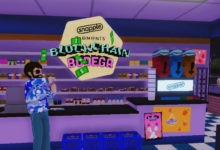Digital Fashion Platform BNV Will Launch Its Own Metaverse

One of the greatest challenges facing the booming digital fashion space—loosely defined as designers and programmers working to dress the virtual avatars that will come to populate the still-nascent metaverse—has been balancing the priorities of both fashion veterans and Web3 pioneers.
Some of the most popular metaverse platforms, like Decentraland and The Sandbox, have gained substantial traction in Web3 circles due to the fact that they operate on a “permissionless” structure: digital assets—like a virtual dress, for example—can flow freely in and out of them.
These same platforms, however, also tend to be built in extremely simplistic 3D styles.
The Sandbox, for example, employs a signature “voxelated” aesthetic (think pixelated, but with cubes). Some industry experts feel such blocky, cartoonish ecosystems are unfit to serve as the testing ground for the future of digital fashion.
“The reality is, a lot of brands don’t really look at The Sandbox—or any voxelated environment—as being conducive to fashion,” Richard Hobbs, CEO of digital fashion platform BNV, told Decrypt in a video interview.
Hobbs believes that BNV—which, in addition to creating digital fashion pieces, also serves as a conduit between traditional fashion brands and design tools for the metaverse—may have solved this dilemma. Within the next month, the company plans to roll out a beta version of its own metaverse platform, BNV World, which will be specifically tailored to showcasing complex and intricate digital fashion pieces for citizens of the metaverse.
BNV World will be built with Unreal Engine, the lifelike graphics software tool from Fornite creator Epic Games. Hobbs believes the flexibility offered by Unreal will be key to attracting the enthusiasm of fashion leaders reticent about the design limitations of current metaverses.
“Those experiences, those metaverses, which are being built or dreamed of being built using Unreal, are the ones where I think you’ll get the most traction with fashion brands,” Hobbs said. “You can use the power of Unreal to show material physics in a way that’s different. [Before], there was no movement in the materials, they were literally rigged to the avatar, and that was it.”
BNV World will allow visitors to showcase fashion pieces from a myriad of designers in ultra-realistic 3D, and will feature a platform-exclusive marketplace for BNV products. There will also be virtual spaces and stages designed for events and digital fashion collection launches. Certain areas of the platform will be token-gated, offering NFT holders “different levels of accessibility and wearability.”
Hobbs is confident that creating a virtual space that is first and foremost intended to cater to the visual demands of digital fashion will allow creators to “be a lot more creative and experimental with how fashion can look and be interpreted in the metaverse.”
Why Big Brands Won’t Rule Fashion in the Metaverse
Luxury fashion brands have begun experimenting with presences in the metaverse, although the fruits of those endeavors have yet to truly materialize.
In February, Gucci purchased an undisclosed amount of virtual land in The Sandbox, upon which it will build themed spaces and sell digital fashion items. French ultra-luxury fashion house Balmain is currently developing a metaverse ecosystem designed to lure its exclusive clientele with tiered, immersive experiences. Balmain has not yet disclosed which metaverse platform it plans to build in.






 Bitcoin
Bitcoin  Ethereum
Ethereum  Tether
Tether  USDC
USDC  TRON
TRON  Dogecoin
Dogecoin  Cardano
Cardano  Bitcoin Cash
Bitcoin Cash  Chainlink
Chainlink  Monero
Monero  LEO Token
LEO Token  Stellar
Stellar  Zcash
Zcash  Litecoin
Litecoin  Hedera
Hedera  Dai
Dai  Cronos
Cronos  Tether Gold
Tether Gold  OKB
OKB  Ethereum Classic
Ethereum Classic  KuCoin
KuCoin  Cosmos Hub
Cosmos Hub  Gate
Gate  Algorand
Algorand  VeChain
VeChain  Stacks
Stacks  Tezos
Tezos  TrueUSD
TrueUSD  Dash
Dash  IOTA
IOTA  Basic Attention
Basic Attention  Theta Network
Theta Network  Decred
Decred  NEO
NEO  Synthetix
Synthetix  Qtum
Qtum  Ravencoin
Ravencoin  0x Protocol
0x Protocol  DigiByte
DigiByte  Zilliqa
Zilliqa  Nano
Nano  Holo
Holo  Siacoin
Siacoin  Numeraire
Numeraire  Waves
Waves  Status
Status  Ontology
Ontology  Enjin Coin
Enjin Coin  BUSD
BUSD  Hive
Hive  Pax Dollar
Pax Dollar  Lisk
Lisk  Steem
Steem  Huobi
Huobi  Bitcoin Gold
Bitcoin Gold  OMG Network
OMG Network  NEM
NEM  Augur
Augur  Bitcoin Diamond
Bitcoin Diamond